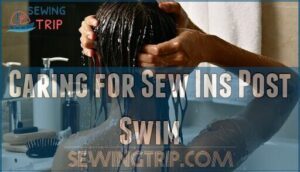This site is supported by our readers. We may earn a commission, at no cost to you, if you purchase through links.

Slip on a snug swim cap, braid or bun your hair, and skip the clip-ins—think of it like protecting your favorite kicks from mud.
After your swim, shampoo and condition gently, detangle with patience, and treat your extensions to a leave-in conditioner.
Quality extensions and consistent maintenance are your lifelines, helping you avoid tangles and damage.
Swimming with a sew in isn’t rocket science, but it does take a little care. Stick around for tips that make pool days with your sew in a breeze.
Table Of Contents
Key Takeaways
- Always prep your sew-in before swimming by wetting it with fresh water, braiding or bunning your hair, and slipping on a snug silicone swim cap.
- Stick with high-quality human hair extensions and avoid synthetic or clip-in pieces for better durability in chlorine or saltwater.
- After swimming, gently shampoo, condition, and detangle your sew-in, then use a leave-in conditioner to restore moisture.
- Limit swim sessions to a couple times a week and follow up with consistent maintenance to keep your extensions looking fresh and healthy.
Swimming With Sew Ins
You can swim with sew-in extensions, but it requires careful preparation and protective measures to prevent damage.
The key is taking steps before, during, and after swimming to maintain your extensions’ quality and longevity.
Pre Swim Preparation
Before diving into sew in swimming, proper preparation sets you up for success.
Start by saturating your hair with fresh water – this water saturation prevents chlorine absorption. Apply a protective oil barrier using coconut or argan oil, focusing on mid-lengths and ends.
For hydration importance, use leave-in conditioner with SPF protection. A great choice would be to use a quality hair product before swimming.
Product application should create a moisture shield. Finally, secure hair in loose braids – braid benefits include reduced tangling and easier post-swim care for protecting sew in extensions.
Choosing Right Extensions
The foundation of safe sew in swimming starts with smart extension material choices.
Human hair extensions outperform synthetic options when facing chlorine and saltwater challenges. To mitigate these effects, it’s essential to recognize how chlorine weakens extension bonds.
- Hair type: Choose virgin or natural-wave textures that resist tangling and maintain integrity underwater
- Extension material: Select high-quality human hair over synthetic for better durability and styling flexibility after swimming
- Color matching: Pick shades closest to your natural hair to minimize blending issues post-swim
- Length selection: Consider shorter lengths for easier maintenance and reduced weight when wet
Protective Measures
Beyond pre-swim prep, you’ll want bulletproof protective measures for your sew-in. Think of these strategies as your hair’s armor against chlorine and saltwater damage. Smart protection means longer-lasting extensions and fewer salon visits.
| Protection Method | Key Benefits |
|---|---|
| Oil Barrier Application | Creates waterproof seal, prevents chemical absorption |
| Secure Braiding Technique | Minimizes tangling, reduces friction damage |
| Proper Cap Sealing | Blocks water entry, maintains style integrity |
| UV Protection Products | Shields from sun damage, prevents color fading |
| Limiting Immersion Time | Reduces exposure risk, preserves extension bonds |
These protective measures work together like a dream team. Apply your oil barrier first, then secure braiding keeps everything in place. Your swim cap sew in becomes the final fortress against water damage. Remember, chlorine protection and saltwater protection aren’t just nice-to-haves – they’re essentials for swimming with weave successfully.
How to Swim With Sew In
Swimming with a sew in requires smart preparation and realistic expectations. Your extensions can handle occasional water exposure, but they’re not built for daily pool sessions.
Enjoy the water, but remember—your sew-in thrives with moderation and a little extra care before and after each swim.
Here’s your game plan:
- Wet hair with fresh water first – This prevents your weave from absorbing as much chlorine or saltwater
- Apply leave-in conditioner generously – Creates a protective barrier against chemical damage
- Secure hair in braids or a low bun – Minimizes tangling and reduces weave damage during movement
- Limit swimming time to 2 hours maximum – Extended exposure increases product buildup and drying
Remember, swimming with weave isn’t about avoiding water completely—it’s about being strategic. Chlorine exposure and saltwater effects can weaken your extensions over time, so moderation is key.
Your sew in care routine becomes essential after each swim. Consider using a product like Ouidad Curl Deep Conditioner to replenish moisture after swimming. Think of it as a balancing act between enjoying summer fun and maintaining your investment in quality hair extensions.
Protecting Hair Extensions
When you’re ready to hit the water with your sew-in extensions, taking proper protective measures can mean the difference between maintaining gorgeous hair and dealing with a tangled mess.
You’ll want to focus on three key strategies that work together to shield your investment from chlorine, salt water, and the general chaos that comes with swimming, using methods that effectively protect your extensions.
Remove Clip Ins
Clip-in extensions become your hair’s worst enemy underwater. Before taking the plunge, remove all clip-in alternatives to prevent water damage and guarantee swimming safety.
These temporary pieces weren’t designed for aquatic adventures, and saltwater or chlorine will wreak havoc on their delicate structure. Your sew in protection starts with smart pre-swim removal, guaranteeing extension longevity through proper sew in care and maintenance.
After removal, remember to detangle hair gently for superior hair health.
Cover With Swim Cap
A swim cap acts as your hair’s best friend in the water. Choose silicone caps for superior protection—they reduce water penetration by up to 90% compared to latex options.
Essential swim cap steps:
- Secure all hair under the cap, tucking sew-in tracks flat
- Apply gel around hairline for a tighter seal
- Check for bulkiness that might compromise the fit
- Consider double-capping for maximum swimming hair extensions protection
Quality cap material makes all the difference for sew in protection. For added security, consider using swim cap extensions.
Braid or Bun Hair
After covering swim caps, styling your sew-in extensions properly creates another layer of protection.
Smart braid styles and bun variations offer secure hold while maintaining hair health and style longevity.
These protective swimming tips for sew-in maintenance help preserve your investment through careful hair braiding techniques.
| Style | Security Level | Best For |
|---|---|---|
| Dutch braids | High | Active swimming |
| Low bun | Medium | Casual pool time |
| French twist | High | Extended water activities |
You’ll want to secure loose ends tightly, ensuring your swimming hair extensions stay put while reducing tangles and potential damage from constant water movement, which is crucial for hair health and style longevity.
Caring for Sew Ins Post Swim
After swimming, you’ll need to act quickly to prevent your sew-in from becoming a tangled mess.
Quick post-swim care keeps your sew-in smooth and tangle-free, so you can enjoy every dip stress-free.
The key is thorough cleansing and gentle handling to restore your extensions’ health and appearance.
Shampoo and Condition
Right after swimming, you’ll want to wash your extensions with sulfate-free shampoo to remove chlorine damage while protecting scalp health.
Focus on gentle cleansing that maintains hydration balance without stripping natural oils. Using sulfate-free options can help.
Follow with deep conditioning treatments – this sew in aftercare step restores moisture lost during swimming. These swimming tips sew in maintenance routines prevent long-term damage and keep your hair washing routine effective and promote healthy hair.
Gently Detangle
After a swim, gently detangling your sew in is key. Grab a wide-tooth comb and start at the ends, working up to avoid breakage.
Sectioning hair makes the job easier—think of it as untangling a necklace, not wrestling a sea monster. Use detangling sprays for added slip and better hair manageability.
Remember to condition to keep your sew-in, as sulfate-free conditioner is key to maintaining the weave. Patience pays off in sew in maintenance, and using a sulfate-free conditioner is crucial.
Apply Leave in Conditioner
After a swim, reach for your leave-in conditioner—it’s your secret weapon for hair moisture and extension care.
Focus on gentle application techniques, working product ingredients through damp hair.
Conditioner benefits all hair types, especially when swimming with sew-in hair extensions. Use leave-in frequency wisely; too much can weigh hair down, too little leaves it thirsty.
Dry thoroughly for best results.
Maintaining Sew in Extensions
If you want your sew in extensions to last, you’ve got to stick to regular care and use quality products.
Don’t let a few laps in the pool turn your hair into a tangled mess—consistent maintenance helps keep everything looking smooth and healthy.
Quality Extensions Matter
After post-swim care, the real secret to hair extension longevity is picking high-quality weave.
You’ll thank yourself for investing in a professional install and premium hair. Cheap hair gets heavy and tangles fast—nobody wants that.
Remember to factor in chlorine requires proper conditioning to maintain hair health.
Consider:
- Remy hair for swimming with sewin hair extensions
- Cost analysis for best hair quality
- Weave type impacts overall extension longevity
Consistent Maintenance
In the case of swimming with sewin hair extensions, consistent maintenance is your best friend.
Stick to a Hydration Routine, check Scalp Health often, and don’t skip Regular Trims.
Night Protection—like a silk scarf—keeps tangles at bay.
Watch for Product Buildup after pool days, and remember that Hair weave care isn’t glamorous, but it keeps your hair protection game strong.
Avoiding Damage
Think of your sewin hair extensions like a favorite pair of sneakers—Chlorine Exposure, Saltwater Effects, and UV Protection can wear them down fast.
Always rinse after swimming with hair extensions to prevent Product Buildup and Knot Prevention woes.
Use a swim proof sew in, braid before diving, and choose products that fight chlorine and salt effects for exceptional hair extension care.
Frequently Asked Questions (FAQs)
How to protect sew in while swimming?
Before you get started, braid your sew-in, saturate it with fresh water, and use a silicone swim cap for snug protection.
After swimming, rinse out chlorine, condition well, and dry thoroughly—your hair will thank you later.
Can you wear sew-ins in water?
You can wear sew-ins in water, but you’ll want to prep first—braid your hair, use a swim cap, and apply leave-in conditioner.
Water won’t ruin sew-ins, but skipping care could leave you tangled and frustrated.
How to protect hair extensions in a swimming pool?
When you fancy a splash, tuck those extensions under a snug silicone swim cap, braid your hair for extra security, and slather on leave-in conditioner.
Quick rinses and gentle towel drying after swimming keep everything looking fresh.
Can I swim in saltwater with a sew-in?
You can swim in saltwater with a sew-in, but prep your hair first—rinse with fresh water, braid it, and use a silicone swim cap.
Afterward, wash and condition thoroughly to keep your weave looking fresh.
How often can I swim with a sew-in installed?
Let’s say you’re chasing summer vibes—swimming with a sew-in is fine once or twice a week, but daily dips can wear out your extensions.
Give your hair breaks, and always follow up with extra TLC.
Will pool chemicals change my sew-in color?
Pool chemicals can fade or even shift your sew-in’s color—think of it like your favorite tee losing its vibrancy in the wash.
Rinse your hair before and after swimming, and consider using a swim cap for backup.
Can I use regular hair products after swimming?
Here’s the twist: after a dip, you can use your usual hair products, but make sure they’re gentle and moisturizing.
Harsh stuff dries out your weave—think of your sew-in as thirsty after swimming, not invincible.
Is it safe to use heat tools post-swim?
Using heat tools after a dip can be tricky—wait until your hair’s completely dry and well-conditioned.
If you rush it, you’ll fry your strands quicker than a forgotten marshmallow at a campfire.
Proceed with care!
Conclusion
Think of your sew in like a favorite hoodie—keep it clean, dry, and protected, and it’ll last through any adventure, even a swim.
If you’re figuring out how to go swimming with a sew in, remember: a swim cap, braids or a bun, and gentle post-swim care are your best friends.
Choose quality extensions, stay consistent with maintenance, and skip the shortcuts.
With these tips, you’ll enjoy pool days without stressing over tangles or damage, and have a great time.
- https://panacheck.com/blogs/can-you-swim-with-hair-extensions/
- https://www.fabulive.com/blogs/news/hair-extensions-swimming-what-you-need-to-know
- https://www.styleseat.com/blog/best-hair-sew-in-weave/
- https://www.youtube.com/watch?v=xjzAAadsicI
- https://www.reddit.com/r/Naturalhair/comments/11489tx/sew_in_on_vacation/











